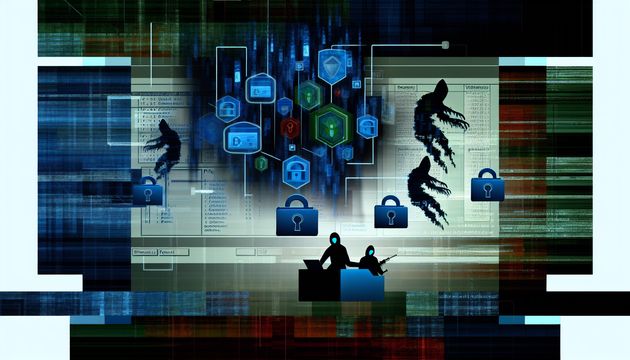
The Transformative Power of Automation in Cybersecurity
In today’s digital age, cybersecurity is undergoing a significant transformation, with automation at the forefront of enhancing threat detection and response capabilities. By harnessing advanced technologies like artificial intelligence (AI) and machine learning (ML), organizations can quickly sift through vast datasets to pinpoint potential threats. This ability is crucial for spotting anomalies and patterns that might signal malicious activities, enabling swift responses. For example, AI-driven systems can continuously monitor network traffic, identifying suspicious activities that stray from normal patterns, thereby drastically cutting down the time needed to detect and address threats (Simeon on Security).
Seamless integration of automation into existing security processes is key to maximizing its benefits. Organizations should focus on automating critical areas like early threat detection and vulnerability management to ensure that automated solutions complement human teams (Telefonica Tech). However, it’s important to balance automation with human oversight to prevent unintended outcomes, as automated systems can sometimes produce false positives or overlook subtle threats (Medium).
Automation’s Role in Cybersecurity
Enhancing Threat Detection and Response
Automation is revolutionizing threat detection and response within cybersecurity frameworks. By leveraging AI and ML, automated systems can rapidly analyze large volumes of data to identify potential threats. These systems can detect anomalies and patterns that may indicate malicious activities, enabling organizations to respond promptly. For instance, AI-driven automation can monitor network traffic in real-time, flagging suspicious activities that deviate from established baselines. This capability significantly reduces the time required to detect and mitigate threats, enhancing the overall security posture of organizations. (Simeon on Security)
Integration with Existing Security Processes
Integrating automation into existing security processes is crucial for maximizing its effectiveness. Organizations must assess and prioritize critical areas for automation, such as early threat detection and vulnerability management. By doing so, they can create modular automation scripts that adapt to evolving threats. This integration ensures that automated solutions work in harmony with human teams, enhancing the overall efficiency of cybersecurity operations. For example, automation can handle routine tasks such as log analysis and incident reporting, freeing up human analysts to focus on more complex issues. (Telefonica Tech)
Balancing Automation with Human Oversight
While automation offers significant opportunities for improving cybersecurity, it also presents risks that must be carefully managed. One of the key challenges is balancing automation with human oversight to avoid unintended consequences. Automated systems can sometimes generate false positives or miss subtle threats that require human intuition and expertise to identify. Therefore, organizations must implement strategies that combine the strengths of automation with human judgment. This approach ensures robust security outcomes by leveraging the speed and efficiency of automation while maintaining the critical thinking and adaptability of human analysts. (Medium)
AI-Powered Automation and Real-Time Detection
AI-powered automation is transforming real-time threat detection in cybersecurity. By processing large volumes of data quickly, AI systems can identify and respond to threats as they occur. This capability is particularly valuable in environments where the speed of response is critical to preventing damage. For example, AI can automatically isolate compromised systems, block malicious IP addresses, and initiate incident response protocols without human intervention. However, integrating AI into cybersecurity practices also introduces vulnerabilities that must be addressed, such as the potential for AI models to be manipulated by adversaries. Organizations must therefore implement robust security measures to protect AI systems from exploitation. (Automation.com)
Automation in the Hands of Cybercriminals
As automation becomes more prevalent in cybersecurity, it is also being leveraged by cybercriminals to enhance their attack strategies. Automated tools can be used to launch large-scale attacks, such as distributed denial-of-service (DDoS) attacks, with minimal effort. Cybercriminals can also use automation to scan for vulnerabilities and exploit them at scale, increasing the frequency and impact of cyberattacks. This dual use of automation underscores the importance of staying ahead of adversaries by continuously updating and improving automated security measures. Organizations must also collaborate with industry peers and government agencies to share threat intelligence and develop collective defense strategies. (AI Plus Info)
Reducing Security Team Overload
Security teams are often overwhelmed by the sheer volume of alerts and incidents they must manage. Automation can alleviate this burden by handling routine tasks and filtering out false positives, allowing human analysts to focus on high-priority threats. For example, automated systems can prioritize alerts based on severity and context, ensuring that security teams address the most critical issues first. This approach not only improves the efficiency of security operations but also reduces the risk of burnout among security professionals. By streamlining workflows and enhancing decision-making, automation enables security teams to operate more effectively in a rapidly evolving threat landscape. (Security Magazine)
Future Trends and Challenges
Looking ahead, the role of automation in cybersecurity is expected to expand as organizations continue to face increasingly complex threats. Emerging technologies such as quantum computing and blockchain may offer new opportunities for enhancing security, but they also present new challenges. For instance, quantum computing could potentially break current encryption standards, necessitating the development of quantum-resistant algorithms. Additionally, the integration of automation with these technologies will require careful planning and coordination to ensure interoperability and effectiveness. Organizations must remain vigilant and adaptable, continuously evolving their security strategies to address new threats and leverage technological advancements. (Forbes)
Leveraging AI for Predictive Security
AI’s predictive capabilities are transforming how organizations approach cybersecurity. By analyzing historical data and identifying patterns, AI systems can predict potential threats and vulnerabilities before they materialize. This proactive approach allows organizations to implement preventive measures and reduce the likelihood of successful attacks. For example, AI can identify emerging trends in malware development and recommend updates to security protocols accordingly. However, the accuracy of AI predictions depends on the quality and diversity of the data used to train the models. Organizations must therefore invest in comprehensive data collection and analysis to maximize the benefits of predictive security. (KPMG)
Final Thoughts
As automation continues to transform cybersecurity, it is essential for organizations to stay ahead of adversaries by continuously updating and improving automated security measures. The dual use of automation by both defenders and attackers underscores the importance of collaboration among industry peers and government agencies to share threat intelligence and develop collective defense strategies (AI Plus Info).
Looking forward, the integration of emerging technologies such as quantum computing and blockchain with automation presents both opportunities and challenges. Organizations must remain vigilant and adaptable, evolving their security strategies to address new threats and leverage technological advancements (Forbes). By leveraging AI for predictive security, organizations can proactively implement preventive measures, reducing the likelihood of successful attacks (KPMG).
References
- Simeon on Security. (n.d.). Deep dive into security automation: Strategies and implementation. https://simeononsecurity.com/articles/deep-dive-into-security-automation_-strategies-and-implementation/
- Telefonica Tech. (n.d.). Cybersecurity automation with AI to anticipate and neutralize threats. https://telefonicatech.com/en/blog/cybersecurity-automation-with-ai-to-anticipate-and-neutralize-threats
- Medium. (n.d.). Automation in cybersecurity: Opportunities and risks. https://medium.com/@costigermano/automation-in-cybersecurity-opportunities-and-risks-43fcec41e5ad
- AI Plus Info. (n.d.). Cybersecurity 2025: Automation and AI risks. https://www.aiplusinfo.com/blog/cybersecurity-2025-automation-and-ai-risks/
- Forbes. (2025, January 21). The state of AI cybersecurity in 2025 and beyond. https://www.forbes.com/councils/forbestechcouncil/2025/01/21/the-state-of-ai-cybersecurity-in-2025-and-beyond/
- KPMG. (2025). Future of security automation. https://kpmg.com/us/en/articles/2025/future-of-security-automation.html



